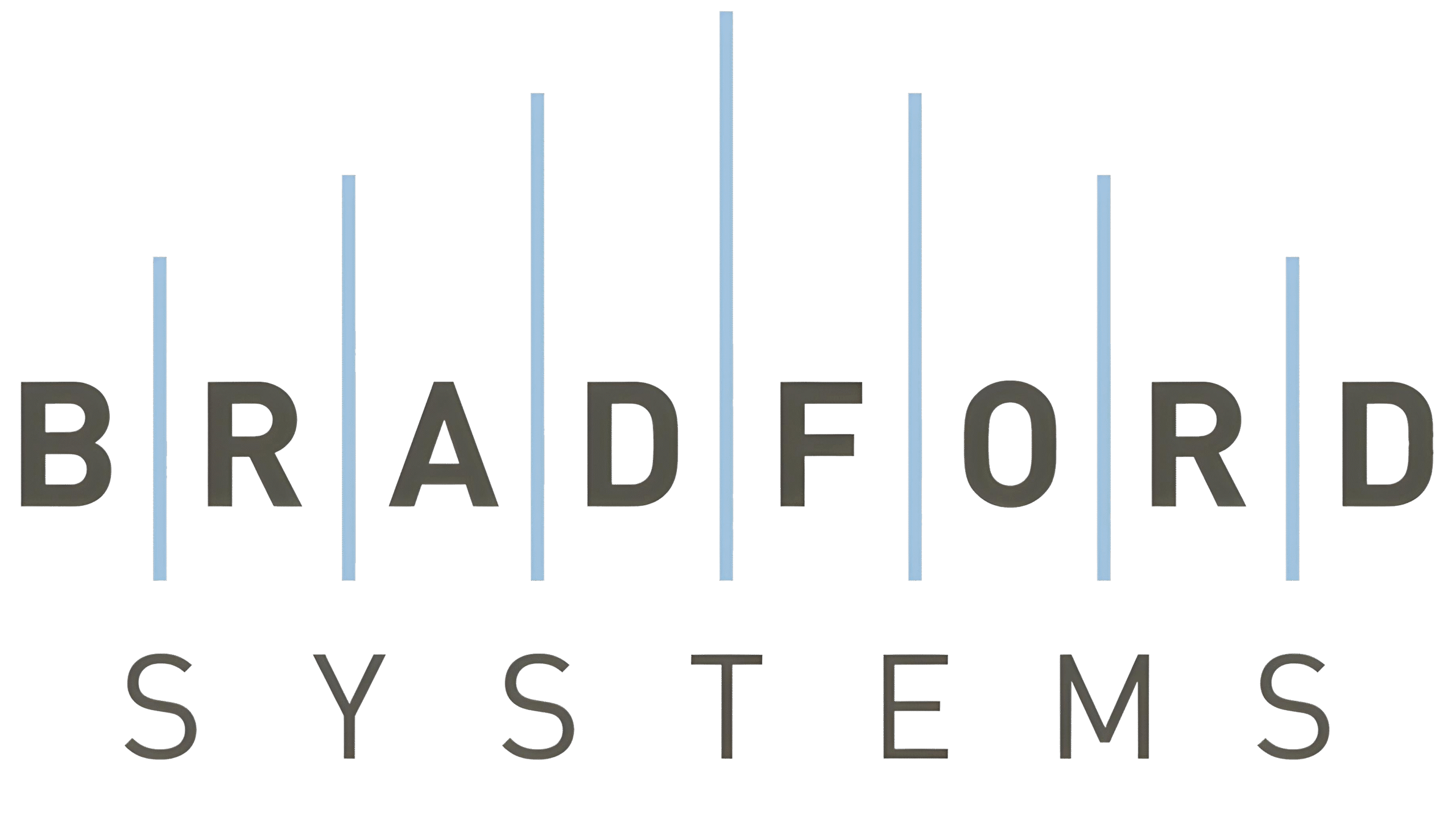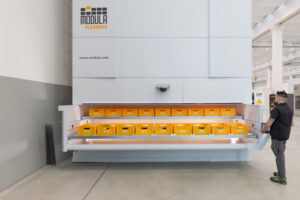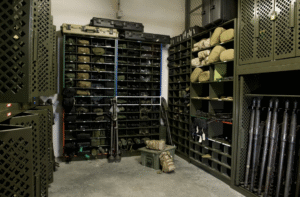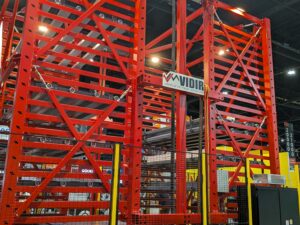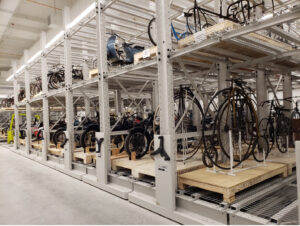Welcome to the world of warehouse management, where space is a precious commodity, organization is key, and the right storage equipment can make or break your operational efficiency. For corporate office managers looking to streamline their storage requirements and maximize their workspace, understanding the nuances of warehouse racking equipment can be a game-changer. This article takes you through the evolutionary journey of warehouse racking equipment, unearthing its potential to redefine your storage space and transform your business operations.
Warehouse racking equipment has come a long way since its inception. From simple wooden shelving units to sophisticated pallet racking systems, this essential element of warehouse management has undergone a significant transformation. Today, warehouse racking systems are not just about storing goods. They are about optimizing space, improving accessibility, and boosting operational efficiency.
As a corporate office manager, you might be grappling with limited storage space, disorganized filing systems, or inefficient storage methods. The solution to these challenges lies in embracing the revolution in warehouse racking equipment. This involves understanding the various types of racking systems, their specific uses, and how they can help you overcome your storage woes.
In the following sections, we will delve deeper into the various aspects of warehouse racking equipment, including OSHA requirements, differentiating between warehouse shelving and racking, exploring common types of racks, and how Bradford Systems is revolutionizing this space. We will also discuss how warehouse racking equipment can optimize your space and what the future holds for this crucial component of warehouse management.
Whether you’re looking for storage racks, pallet racks, or warehouse shelving systems, this comprehensive guide will equip you with the knowledge and insights you need to make informed decisions. So, let’s dive in and explore the revolution in warehouse racking equipment, and how it’s redefining the space in which we work and operate.
Understanding OSHA Requirements for Warehouse Racking
Unveiling the secrets of warehouse organization is a bit like peeling an onion; each layer reveals yet another. An integral layer of this process is understanding the OSHA requirements for warehouse racking. As a corporate office manager, you hold a responsibility to ensure the safety and stability of your storage systems, and OSHA (Occupational Safety and Health Administration) provides the necessary guidelines to do so.
The Importance of Stability and Security in Stacking
As the saying goes, a chain is only as strong as its weakest link. When it comes to warehouse racking, the stability of your storage system is paramount. According to OSHA requirements, items stored in tiers (such as bags, containers, or bundles) must be stacked, blocked, interlocked, and limited in height to ensure they are stable and secure against sliding or collapse. This is not only a crucial aspect of maintaining a safe working environment, but it also significantly reduces the risk of damage to your products and the potential for costly downtime due to accidents or injuries.
The Need for Certification in Industrial Racking
In the world of warehouse racking, not all racks are created equal. The quality of your storage system can significantly impact its performance and lifespan. That’s why it’s essential to choose manufacturers of industrial racking that hold specific certifications for the type of product they market. This ensures that your storage system adheres to the relevant standards and provides the level of quality and durability you need. Remember, a certified racking system isn’t just a smart investment—it’s a requirement in many jurisdictions.
Bradford Systems understands the importance of these OSHA requirements and the need for certified, stable, and secure warehouse racking. In the next section, we’ll explore the differences between warehouse shelving and racking, and how understanding these variations can help you make the best choice for your business.
Differentiating Between Warehouse Shelving and Racking
When it comes to optimizing your warehouse or office space, understanding the differences between warehouse shelving and racking is essential. At the core, the distinction lies in the type and size of the products they accommodate. Let’s delve into these differences to help you make the right choice for your storage needs.
The Role of Size and Type of Products in Choosing Between Shelving and Racking
Warehouse racking and shelving are two different storage solutions designed to cater to varying storage needs. The choice between them largely depends on the size and type of items you need to store.
Warehouse racking is best suited for storing larger, heavier items. It’s designed to handle significant weight, making it a perfect solution for storing palletized goods or bulky equipment. Pallet racking systems, for instance, are ideal for accommodating large, heavy items, providing a robust and sturdy storage solution.
On the other hand, warehouse shelving is designed to hold smaller, lighter items. This type of storage is typically used for items that are easier to retrieve and carry by hand. If you’re dealing with smaller items that require easy access, shelving may be a better choice than racking.
The Benefits of Grouping Similar Goods Together in Shelving
One of the main advantages of warehouse shelving over racking is the ability to group similar goods together. Products are often stored individually on shelves, allowing for a more organized and systematic approach to inventory management.
This method of storage not only enhances organization but also streamlines operations, reducing the time spent searching for items. By categorizing items and placing them on labeled shelves, workers can quickly locate what they need.
Moreover, efficient organization provided by shelving systems can also reduce the risk of errors and accidents associated with disorganized storage. This aspect is particularly beneficial in a fast-paced business environment where safety and efficiency are paramount.
In summary, the choice between warehouse shelving and racking should be based on your specific storage needs, considering the size and type of items to be stored. At Bradford Systems, we offer both shelving and racking options, ensuring that we have the right solution to meet your unique storage requirements.
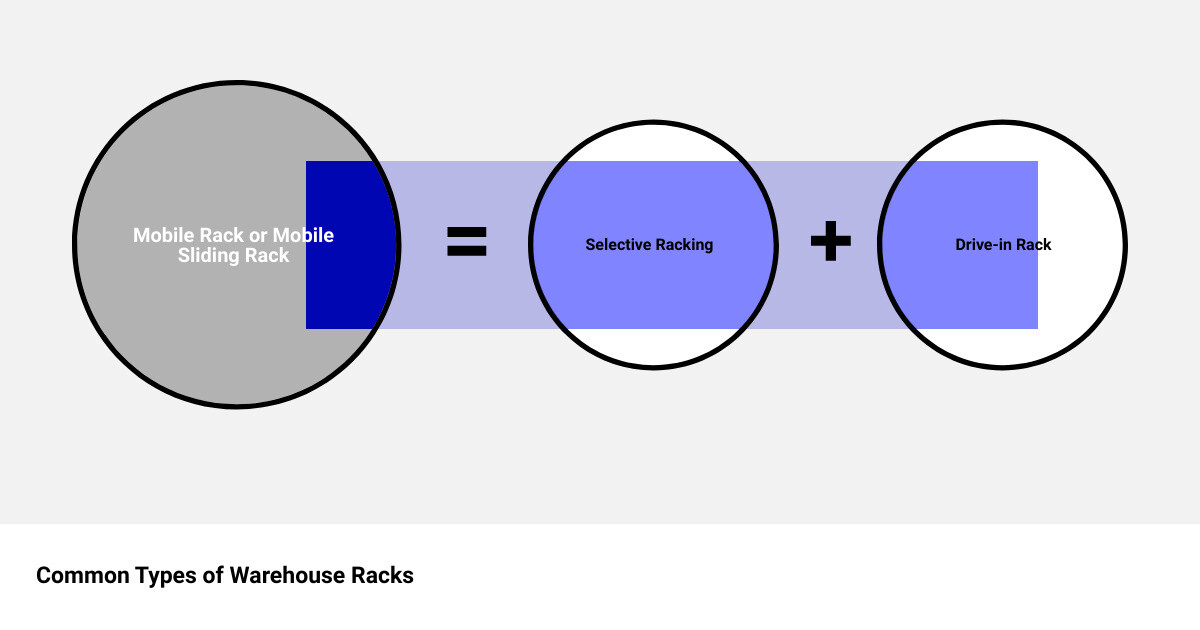
Exploring the Three Common Types of Racks
Faced with a plethora of storage options, it’s crucial to understand the key features and benefits of different types of warehouse racking systems. This knowledge empowers you to make an informed decision, ensuring that the chosen system aligns with your storage needs and business operations. Let’s delve into the three common types of racks: Selective Racking, Drive-in Rack, and Mobile Rack or Mobile Sliding Rack.
The Simplicity and Efficiency of Selective Racking
As the name implies, Selective Racking is all about choice. It offers the convenience of 100% SKU selectivity, meaning you can access any pallet at any time without the need to move or rearrange other items. This makes Selective Racking a popular choice for businesses that store a wide variety of products, each requiring its own space. The simplicity and flexibility of this system make it an efficient choice for businesses with large SKU counts and lower turnover rates.
The Space-Saving Benefits of Drive-in Rack
For businesses seeking to maximize their storage capacity, the Drive-in Rack is a game-changer. Its design allows forklifts to drive directly into the rack, enabling high-density storage. Pallets are stored on rails running the depth of the rack, creating a last-in, first-out (LIFO) inventory management system. This high-density solution is ideal for businesses with fewer SKU types but higher quantities, where space utilization is a priority.
The Convenience of Mobile Rack or Mobile Sliding Rack
Finally, Mobile Rack or Mobile Sliding Rack systems are an excellent solution for businesses with limited warehouse space. These systems operate on tracks, allowing the racks to move along the floor, eliminating the need for multiple fixed aisles. The result is a significant increase in storage density, enabling you to store more items in the same floor space. These mobile systems provide easy access to products while offering a flexible and scalable solution, particularly beneficial for businesses experiencing growth or seasonal fluctuations in inventory.
Understanding these three common types of warehouse racking equipment is a great starting point when considering storage solutions. Whether it’s the simplicity of Selective Racking, the space-saving benefits of Drive-in Rack, or the convenience of Mobile Racking, each type has its own unique advantages to cater to diverse business needs. At Bradford Systems, our expert team can help you navigate these options to find the perfect fit for your business.
Bradford Systems: Revolutionizing Warehouse Racking Equipment
In the realm of warehouse storage solutions, Bradford Systems has carved a unique niche for itself. As a leading provider of innovative storage solutions, the company has redefined the concept of space optimization with its state-of-the-art warehouse racking equipment.
The Unique Selling Proposition of Bradford Systems
At the heart of Bradford Systems’ success is a dedication to innovation and efficiency. The company’s unique selling proposition lies in its commitment to maximizing space, boosting productivity, and improving safety in your warehouse. Utilizing lean manufacturing principles, Bradford Systems offers refined ergonomic equipment and advanced safety solutions that have the potential to extract more value from your operations, driving growth and profitability.
Bradford Systems also stands out for its use of automated storage and retrieval systems (ASRS), such as Modula’s vertical lift modules. These innovative solutions can recover up to 90% of floor space, significantly improving workflows and saving countless hours otherwise spent on searching, picking, and placing materials.
The Variety of Storage Solutions Offered by Bradford Systems
From vertical storage systems that take warehouse storage to new heights to cold storage solutions designed for specific industries, Bradford Systems offers a wide range of storage solutions tailored to the unique needs of various businesses.
The company’s racking systems include everything from pallet racks, drive-in racks, and push-back racks to cantilever racks designed for long, bulky items like lumber or pipes. They also offer carton flow and pallet flow racks, which use gravity to move items through the system for efficient picking.
In addition to racking systems, Bradford Systems provides a variety of other warehouse equipment, including forklifts, industrial carts, and packaging and wrapping machinery. This comprehensive selection ensures that businesses can find all the equipment they need in one place, saving time and resources.
In essence, Bradford Systems is not just a supplier of warehouse racking equipment but a partner in your quest for efficiency, productivity, and space optimization. Whether you’re looking to upgrade your existing warehouse storage system or design a new one from scratch, Bradford Systems has the expertise and the equipment to help you achieve your goals.
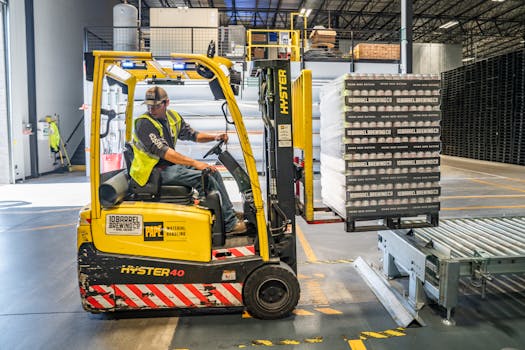
The Impact of Warehouse Racking Equipment on Space Optimization
A well-organized warehouse is more than just a space-saving endeavor—it’s an essential ingredient for operational efficiency, productivity, and profitability. By implementing advanced warehouse racking systems, you can significantly transform your storage space, boost your workflow, and enhance your overall business operations.
How Warehouse Racking Systems Organize Products and Optimize Storage Space
When it comes to organizing products and optimizing storage space, warehouse racking systems are a game-changer. These systems, such as pallet racking, offer an effective way of storing items vertically, providing a significant increase in your storage capacity and freeing up valuable floor space. This approach to vertical storage is not only an excellent space-saving solution but also promotes easy access to stored items, making inventory management a breeze.
By using standardized storage systems like pallet racking, you can maintain uniformity in your storage methods, making it easier to organize and access your inventory. This uniformity reduces the time needed to locate and retrieve items, contributing to an increase in productivity and operational speed. In addition, these systems can be adapted to meet specific storage needs, making them a flexible option for businesses with diverse inventory types.
The Role of Forklifts in Warehouse Storage Systems
Forklifts play a pivotal role within a warehouse storage system. They are the workhorses of the warehouse, being responsible for moving and retrieving products within the racking systems. With a forklift, heavy pallets of goods can be quickly and safely lifted and placed on high shelves, maximizing the use of vertical space. This ability to move heavy loads quickly and efficiently is a key factor in achieving optimal space utilization in your warehouse.
Furthermore, forklifts can enable smoother operations in warehouses with more advanced racking systems such as drive-in or selective racking. These racking types are designed to accommodate forklift operations, allowing for efficient storage and retrieval processes.
The integration of warehouse racking equipment and forklifts can significantly transform your warehouse operations, leading to more efficient use of space, improved inventory management, and overall enhanced productivity. By investing in these systems, you are not just saving space—you are revolutionizing your warehouse operations.
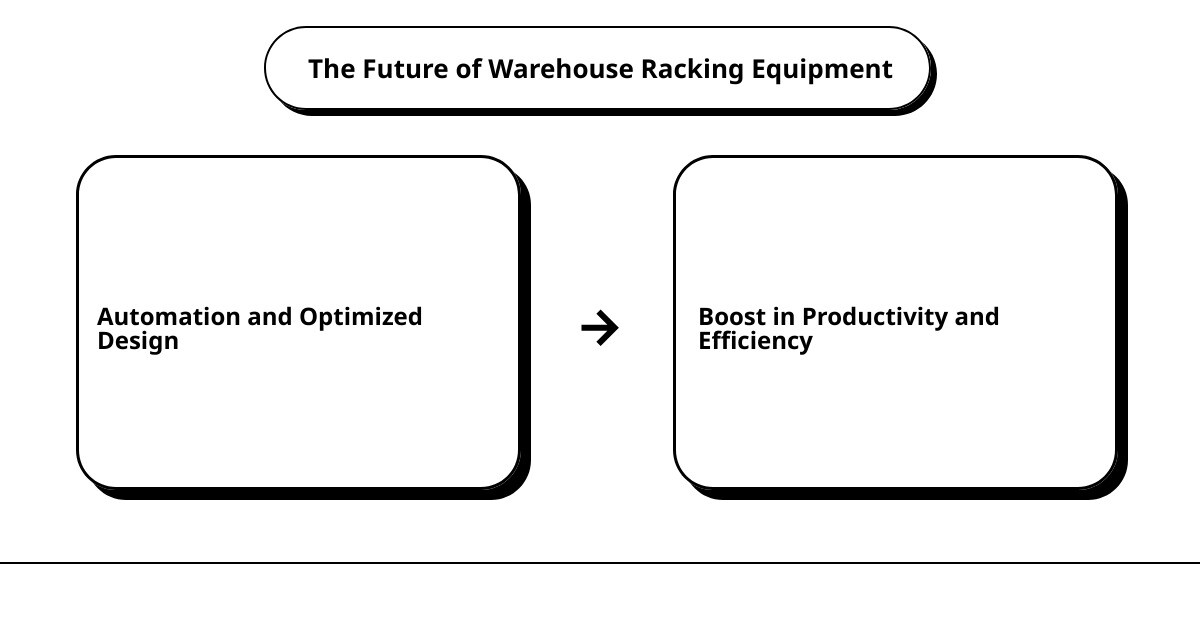
The Future of Warehouse Racking Equipment: Automation and Optimized Design
In the light-speed world of industry, the future is already here. The next frontier in warehouse racking equipment lies in automation and the optimized design of storage systems. These advancements are redefining the way businesses manage their warehouse operations—shaping a future where storage solutions are smarter, faster, and more efficient.
The Increasing Use of Automation in Warehouse Racking Systems
Automation is no longer a futuristic concept—it’s a present reality that’s reshaping warehouse operations. By incorporating automation into industrial storage solutions, businesses can streamline their operations, reduce errors, and improve efficiency significantly. Automated systems are capable of performing tasks much faster than humans, resulting in a higher volume of order processing and product movement in less time.
For instance, automated storage and retrieval systems (AS/RS) can significantly boost efficiency and reduce labor costs by automating the storage and retrieval process. These high-volume operations offer the potential for a revolutionized approach to warehouse racking.
The Importance of Optimized Design in Boosting Productivity and Efficiency
Optimized design in warehouse racking equipment is a game-changer when it comes to productivity and efficiency. The right layout can maximize the use of space, minimize travel time for employees, and improve overall workflow.
Crucial elements of an optimized design include the strategic arrangement of storage solutions, utilization of vertical space, and allocation of designated zones for different tasks. For example, high-density storage solutions like pallet racking or mezzanine floors can utilize the full height of a facility, while maintaining proper aisle widths ensures easy navigation and accommodation for forklifts and other material handling equipment.
Proper planning and design can also help in implementing efficient inventory management practices. For instance, the first-in, first-out (FIFO) method can be used to store items in a way that allows the oldest inventory to be accessed first, reducing the risk of spoilage or obsolescence.
By making these strategic design choices, businesses can improve their warehouse operations, optimize their storage space, and ultimately drive a significant increase in productivity and efficiency.
In the end, the incorporation of automation and the adoption of optimized design in warehouse racking systems are not just trends—they are the future of efficient warehouse operations. They are critical components in the ongoing revolution of warehouse racking equipment, offering businesses the opportunity to redefine their space and elevate their operations to new heights.
Conclusion: The Continuing Revolution in Warehouse Racking Equipment
In the fast-paced world of business, where every square foot and every second counts, the revolution in warehouse racking equipment is far from over. This evolution is driven by innovative companies like Bradford Systems that are at the forefront of providing efficient storage solutions, helping businesses optimize their space and streamline their operations.
From selective racks to drive-in racks and mobile sliding racks, Bradford Systems offers a variety of racking solutions tailored to the specific needs of each business. However, their unique selling proposition goes beyond the provision of racking equipment. Their commitment to quality, safety, and customization, coupled with their robust service offerings like facility layout & space optimization, project management, and national pallet rack installation, sets them apart as a one-stop-shop for all warehouse storage needs.
The rise of automation in warehouse racking systems is another driving factor in this revolution. Automated Storage & Retrieval Systems (ASRS) and conveyor systems are increasingly being adopted by businesses seeking to maximize space and efficiency while reducing labor costs. Automation not only streamlines operations but also minimizes errors, ensuring a smooth flow of goods within the warehouse.
Furthermore, the role of optimized design in boosting productivity and efficiency cannot be overemphasized. From the arrangement of racks to the selection of the right type of racking system, every detail matters. For instance, grouping similar goods together in shelving systems can enhance pick rates and reduce labor costs. Likewise, the use of forklifts in warehouse storage systems can facilitate the efficient handling of goods, further enhancing productivity.
In conclusion, the revolution in warehouse racking equipment is a continuous process, shaped by advancements in technology, innovative design, and the ever-changing needs of businesses. By leveraging these developments, companies can redefine their space, enhance their storage capabilities, and ultimately, stay ahead in the competitive business landscape. As we move forward, it’s clear that the future of warehouse operations lies in the hands of those who embrace these innovative storage solutions.
